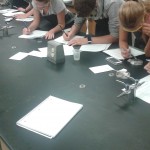The Great Gradeless Experiment #2
Well, after 5 weeks of using the gradeless system, I figured it’s time for an update. If you’re just now joining me, my first post can be found here: https://www.kabt.org/2015/06/26/the-great-gradeless-experiment-1/
We’ve just finished our first unit (Structure and Function), which means we’ve had our first summative assessment. We’ve also submitted our first progress report grades of the year. I’ll be using this update to talk about both of these things.
Summative assessment:
In early August, Steve Young at Olathe East held a workshop over how students learn (if you have a chance to attend in the future, I highly recommend it!). My big “a-ha” learning moment of the workshop also solved a major problem I was having with setting up my gradeless system – How will assess my students?
If you’re following along at home, I’m using a 0-4 scale to assess student learning. This means I need a way to assess students at all levels. I originally thought of including test questions of varying difficulty. Steve Young taught me to differentiate.
I offered my students 3 different exams to choose from. The level 2 exam tested basic skills and vocabulary, the level 3 exam tested application, and the level 4 exam was an open-ended writing assignment. Link to the exams: DNA and Protein Synthesis Test 2015
My students were able to choose which exam they were comfortable taking based on how well they thought they understood the information. Students were encouraged to come in after school to retake the exam at higher difficulties to demonstrate mastery of the content. Exams could be retaken an unlimited number of times.
Most students tested at the level 2 and level 3 level. A handful of students were comfortable (and successful) at level 4. This is about what I expected. Most students were honest about how much they knew and where they were in their learning. Since taking the test, I’ve had a number of students come to me to take the exam at a different level.
Progress report:
A gradeless system doesn’t play very nicely with a more traditional A-F grading system. We’re not bothering with percentages in my class (because honestly, can you tell the difference between student work if one student earned an 88% and another that earned a 92%? I know I can’t.). This means I had to figure out how to translate my 0-4 scales into letter grades. The obvious way would to make an A=4, B=3, C=2, etc., but what happens if you have a student that scores across the board, depending on the content?
I chose to hold individual conferences with each student. During these conferences, I asked each student what letter grade they thought they deserved and why. When students received reviewed work from me, they kept it in a folder in my room. This became their evidence during their conferences. If a student earned mostly 3s and 4s on assignments and wanted an A, they were able to argue for it. Together we decided on the letter that would represent their learning for the first grading period.
Overall, my letter grade recommendation and the students’ matched almost every time. If anything, students tended to underestimate their learning.
These conferences were enjoyable to do – I got to talk to each student one-on-one about their learning and I think it helped students learn to trust me more in regards to this new grading system.
Final thoughts:
This grading system is not perfect yet and I’m still trying to work out a few kinks (like eligibility for athletes), but so far I am pleased with how things are going. It’s still early into the school year, but I feel like the students are starting to worry less about their percentage and letter grade and are focusing more on learning the content.
I gave a presentation over this gradeless system during the Fall KABT conference last Saturday. If you weren’t in attendance, we have the videos linked in the post below. You can also find my PowerPoint at: Going Gradeless PPT
 Previous Post
Previous Post Next Post
Next Post